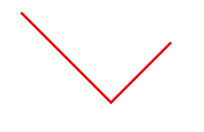Android PathMeasure的使用详解
尊重原创,转载请标明出处 http://blog.csdn.net/abcdef314159
在上一篇的Android Path的使用详解中分析了Path类的一些常用的方法,下面顺便看一下和他有关联的一个类PathMeasure,顾名思义,就是测量Path的,来先看一下注释
/**
* Create an empty PathMeasure object. To uses this to measure the length
* of a path, and/or to find the position and tangent along it, call
* setPath.
*
* Note that once a path is associated with the measure object, it is
* undefined if the path is subsequently modified and the the measure object
* is used. If the path is modified, you must call setPath with the path.
*/
public PathMeasure() {
mPath = null;
native_instance = native_create(0, false);
} /**
* Create a PathMeasure object associated with the specified path object
* (already created and specified). The measure object can now return the
* path's length, and the position and tangent of any position along the
* path.
*
* Note that once a path is associated with the measure object, it is
* undefined if the path is subsequently modified and the the measure object
* is used. If the path is modified, you must call setPath with the path.
*
* @param path The path that will be measured by this object
* @param forceClosed If true, then the path will be considered as "closed"
* even if its contour was not explicitly closed.
*/
public PathMeasure(Path path, boolean forceClosed) {
// The native implementation does not copy the path, prevent it from being GC'd
mPath = path;
native_instance = native_create(path != null ? path.ni() : 0,
forceClosed);
}package test.view;
import android.content.Context;
import android.graphics.Canvas;
import android.graphics.Color;
import android.graphics.Paint;
import android.graphics.Paint.Style;
import android.graphics.Path;
import android.graphics.PathMeasure;
import android.util.AttributeSet;
import android.util.Log;
import android.view.View;
public class PathView extends View {
private Paint mPaint;
private Path mPath;
public PathView(Context context, AttributeSet attrs) {
super(context, attrs);
init();
}
private void init() {
mPaint = new Paint(Paint.ANTI_ALIAS_FLAG);
mPaint.setColor(Color.RED);
mPaint.setStyle(Style.STROKE);
mPaint.setStrokeWidth(8);
mPath = new Path();
mPath.moveTo(100, 100);
mPath.lineTo(400, 400);
mPath.lineTo(600, 200);
Log.d("wld_____", new PathMeasure(mPath, false).getLength() + "");
}
@Override
protected void onDraw(Canvas canvas) {
canvas.drawPath(mPath, mPaint);
}
}
再看一下打印log
![]()
修改一下
Log.d("wld_____", new PathMeasure(mPath, true).getLength() + "");在看一下打印log
![]()
可以看到两个图图形虽然没有变,但测量长度变了。
setPath(Path path, boolean forceClosed)方法和上面的构造方法其实差不多。
getLength()返回path当前轮廓的长度。
getPosTan(float distance, float pos[], float tan[])其中的distance(0<=distance<=getLength()),pos是在长度为distance的点的坐标,其中(x==[0], y==[1]),tan是在那个点的切线的值,其中(x==[0], y==[1]),返回true数据会存入 pos 和 tan 中,返回false,pos 和 tan 不会改变
getMatrix(float distance, Matrix matrix, int flags)得到路径上某一长度的位置以及该位置正切值的矩阵,flags有两种类型
public static final int POSITION_MATRIX_FLAG = 0x01; // must match flags in SkPathMeasure.h
public static final int TANGENT_MATRIX_FLAG = 0x02; // must match flags in SkPathMeasure.hgetSegment(float startD, float stopD, Path dst, boolean startWithMoveTo)根据开始和结束的长度得到path中的一个片段,startWithMoveTo为true表示截取到的位置不会改变,为false表示截取到的会连接在一起,看一下代码。
package test.view;
import android.content.Context;
import android.graphics.Canvas;
import android.graphics.Color;
import android.graphics.Paint;
import android.graphics.Paint.Style;
import android.graphics.Path;
import android.graphics.PathMeasure;
import android.util.AttributeSet;
import android.view.View;
public class PathView extends View {
private Paint mPaint;;
private Path dst;
public PathView(Context context, AttributeSet attrs) {
super(context, attrs);
init();
}
private void init() {
mPaint = new Paint(Paint.ANTI_ALIAS_FLAG);
mPaint.setStyle(Style.STROKE);
mPaint.setStrokeWidth(12);
mPaint.setColor(Color.RED);
dst = new Path();
Path mPath1 = new Path();
mPath1.addRect(200, 200, 600, 600, Path.Direction.CW);
PathMeasure measure1 = new PathMeasure(mPath1, false);
measure1.getSegment(200, 600, dst, true);
Path mPath2 = new Path();
mPath2.addRect(200, 1000, 600, 1400, Path.Direction.CW);
PathMeasure measure = new PathMeasure(mPath2, false);
measure.getSegment(200, 900, dst, true);
}
@Override
protected void onDraw(Canvas canvas) {
canvas.drawPath(dst, mPaint);
}
}
Path mPath1 = new Path();
mPath1.addRect(200, 200, 600, 600, Path.Direction.CW);
PathMeasure measure1 = new PathMeasure(mPath1, false);
measure1.getSegment(200, 600, dst, false);
Path mPath2 = new Path();
mPath2.addRect(200, 1000, 600, 1400, Path.Direction.CW);
PathMeasure measure = new PathMeasure(mPath2, false);
measure.getSegment(200, 900, dst, false);他会找到上一个截取的来进行连接,第一个没有上一个所以连接的为初始位置(0,0)。
isClosed()返回这个路径是否是关闭的。
nextContour()移动到下一个轮廓,因为path可能会有多个轮廓。



